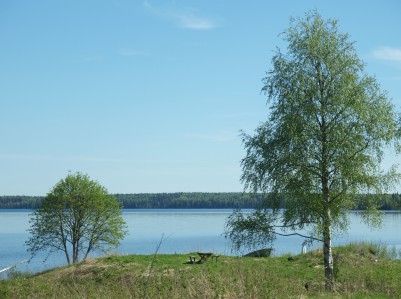Silver Birch

Common Names: Birch, Silver Birch, European White Birch, Curly Birch, Warty Birch, Betula pendula, Betula alba, European Birch, Lady Birch, Weeping Birch, White Birch
Latin Name: Betula pendula
Origin: Asia, Europe, South America, North America
Short Introduction
The optimal conditions for robust silver birch growth are well-drained, deep soils with adequate moisture, particularly during dry periods. Birch trees are easy to cultivate due to their shallow roots and overall hardiness. If provided with sufficient sunlight and moisture, birch thrives virtually anywhere. As a pioneering plant, silver birch demonstrates rapid growth and early fruiting, with a typical lifespan of about 60 years. Historically, birch was cultivated for leather tanning. The bark releases resin when heated, which can be harvested—birch resin is an excellent water-resistant adhesive and effective fire-starting material, even when damp. Dead birch twigs are prized for kindling during outdoor activities.
Detailed Description
Silver Birch is a natural herbal antibiotic and a traditional remedy for gout and rheumatism.
Botanical Information
Silver Birch is a deciduous tree in the birch family, with many different birch species originating from it. It is a relatively fast-growing tree, reaching up to 25 meters in height. Often used for reforestation and ecological reclamation of disturbed land, it plays a vital role in colonizing barren landscapes. Silver Birch is the most common species in its family across Europe due to its resilience to adverse conditions and adaptability to diverse terrain. The tree’s white bark reflects a significant portion of sunlight, contributing to its hardiness. While sometimes considered a weed in commercial forestry, birch wood burns well—even when the bark is wet—despite not being as calorific as some other woods.
Silver Birch tends to be a large tree in temperate climates and appears more shrub-like or stunted in mountain or northern areas. Young trees have brown bark, which transforms to white with age, peeling in thin layers. The bark is excellent for starting fires in nature. The side branches are usually pendant (giving 'pendula' its name), and the slender twigs support small, triangular, serrated leaves that turn yellow in autumn. Sticky buds and male catkins up to 8 cm long are typical, with tiny, wind-dispersed nutlets serving as fruit.
Origin and Distribution
Silver Birch ranges from lowlands to high mountains and northern taigas, where it grows smaller. It occurs in both monocultures and mixed forests and is frequently used to restore human-disturbed landscapes (clearings, burn sites, etc.). Requiring only moderate light and minimal water, its lightweight seeds can be dispersed by wind over great distances. Silver Birch naturally spans from Western Europe eastwards to Kazakhstan, Siberia, Mongolia, and China's eastern provinces, also extending southward to the Caucasus, northern Iran, Iraq, and Turkey. It is found in northern Morocco and has been planted widely around the world, thriving especially in highland regions of southern areas. The species has tolerated pollution and is common even in industrial regions. In North America, known as European White Birch, it is established in states like Kentucky, Washington, and Wisconsin, and does very well throughout Canada.
Usage / Dosage
The collection of birch leaves for traditional herbal use spans centuries, especially among Slavic peoples. In Russia, harvesting birch sap in early spring remains a common practice, though it’s banned elsewhere in Europe and Asia. The leaves contain compounds with a diuretic effect (increasing urine output), which is used to help treat gout and rheumatic diseases. These substances can help partially dissolve joint crystals responsible for severe pain, but adequate hydration is essential. The diuretic properties may also help reduce high blood pressure and are useful in cases of kidney inflammation or colic by supporting kidney filtration. Birch extracts can aid in urinary tract infections and digestive issues, with traditional remedies recommending leaves or root for stomach or intestinal cramps and digestive discomfort. Birch’s anti-inflammatory components may be helpful for painful joint inflammation, lumbago, or sciatica. In dermatology, birch bark decoction is used to rinse itchy allergic rashes, and birch extract is believed to support hair growth and scalp nourishment. Bathing feet in birch decoctions may help with excessive sweating due to its astringent action. Birch preparations are also thought to lower cholesterol levels (primarily LDL cholesterol) and are explored in weight management and obesity therapy. Birch supports immune health and overall wound healing. Traditional decoctions from leaves or bark are valued remedies for respiratory tract illnesses, helping to ease expectoration.
Active Compounds
The bark contains significant amounts of betulin, a triterpenic, steroidal alcohol with notable anti-inflammatory properties. Other important compounds include bitter substances and tannins, which contribute to the plant’s diuretic effect, along with essential oils, resins, and saponins—particularly valuable in respiratory ailments. Birch leaves also contain small amounts of vitamin C.
Traditional Dosage
Preparation and dosage can vary based on intended use. For diuretic purposes, infuse 4 teaspoons of dried birch leaf in 100–150 ml of boiling water, steeping for 5–10 minutes; drink several times daily. For best results, consume between meals and ensure sufficient fluid intake to prevent dehydration. For digestive discomfort, mix 2 teaspoons (about 5–10 grams) of chopped dried leaves with 250 ml of hot white wine; sip throughout the day. The leaves can also be infused in water, though a longer steeping time is recommended.
